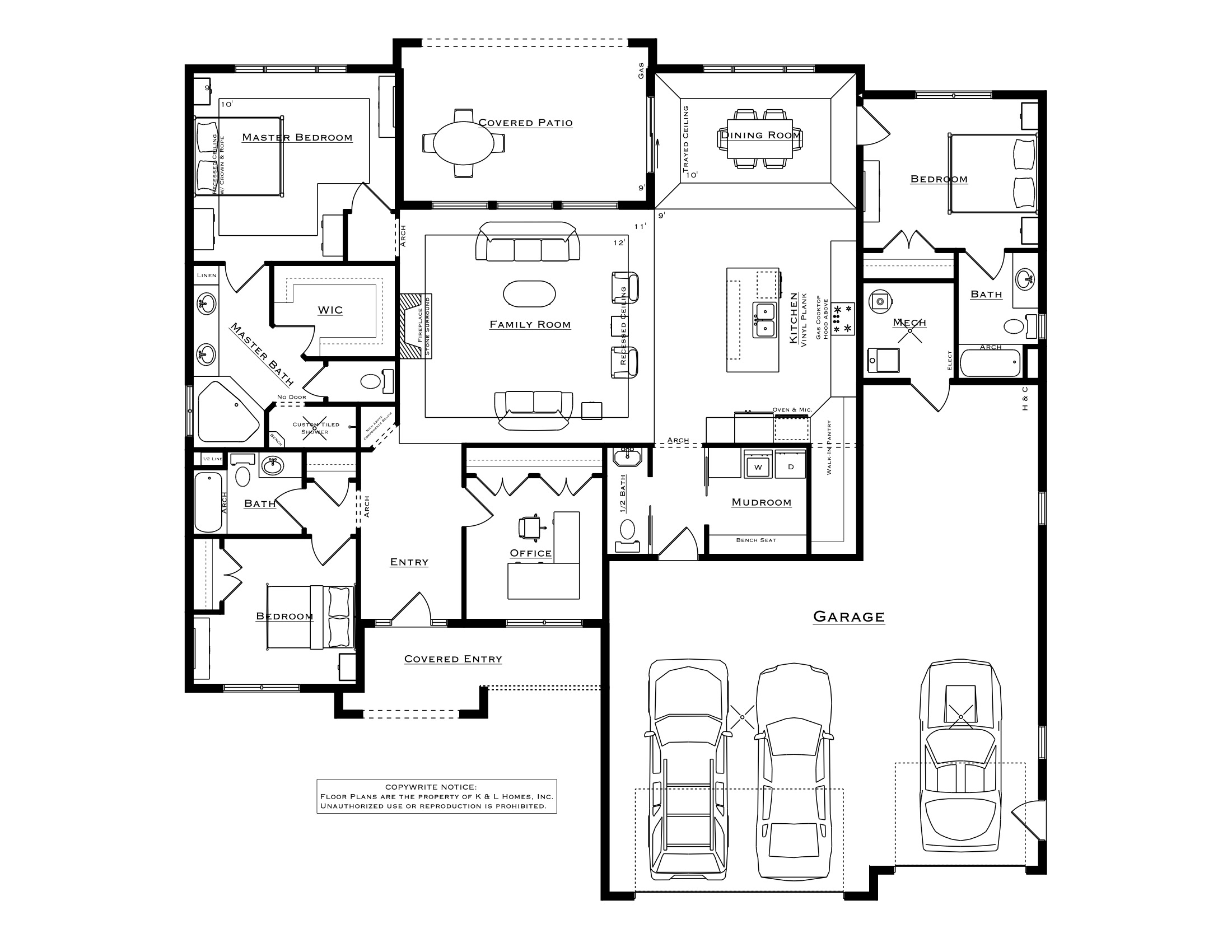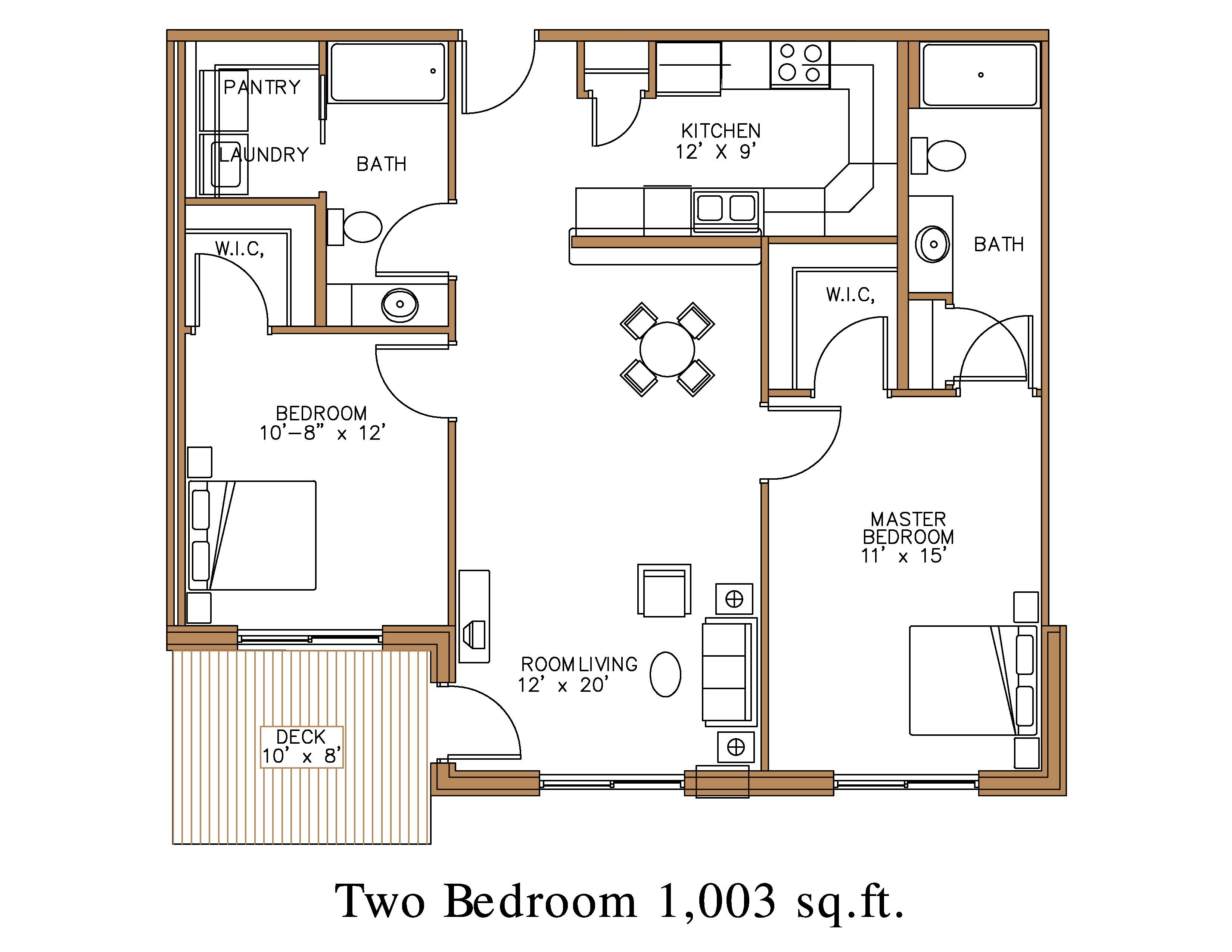Understanding 2-Bedroom Patio Home Plans

Patio homes offer a compelling alternative to traditional single-family homes, particularly for those seeking a lower-maintenance lifestyle and a smaller footprint. These homes are characterized by their attached units, shared walls, and private outdoor spaces, providing a unique blend of community living and personal privacy. This section delves into the key features, benefits, design elements, and architectural styles of 2-bedroom patio homes.
Key Features and Benefits of 2-Bedroom Patio Homes
Patio homes are designed with specific features and benefits that cater to a diverse range of lifestyles.
- Lower Maintenance: Patio homes typically have less exterior space to maintain, with homeowners’ associations often taking care of landscaping and common areas. This frees up time and resources for other pursuits.
- Smaller Footprint: These homes are generally smaller than traditional single-family homes, offering a more manageable living space. This can be advantageous for downsizing or for those who prefer a less cluttered environment.
- Community Living: Living in a patio home community fosters a sense of belonging and connection with neighbors, often with shared amenities like swimming pools, community centers, or walking trails.
- Security and Privacy: The attached units offer a sense of security and shared vigilance, while the private patios provide a secluded space for relaxation and outdoor activities.
- Affordability: Patio homes often offer a more affordable option compared to traditional single-family homes, particularly in desirable locations.
Typical Layout and Design Elements
The layout of a 2-bedroom patio home typically prioritizes efficient use of space and functionality.
- Open Floor Plans: Patio homes often feature open floor plans that seamlessly connect the living, dining, and kitchen areas, creating a spacious and airy feel.
- Private Patios: The patio is a key element of patio homes, offering a dedicated outdoor space for relaxation, entertaining, or gardening. These patios can be accessed directly from the living areas or bedrooms, providing a seamless transition between indoor and outdoor living.
- Master Suites: Many 2-bedroom patio homes include a master suite with a private bathroom and walk-in closet, offering a luxurious and comfortable retreat.
- Energy Efficiency: Patio homes often incorporate energy-efficient features such as insulation, high-performance windows, and energy-saving appliances, contributing to lower utility costs and environmental sustainability.
Comparison with Traditional Single-Family Homes
Patio homes differ from traditional single-family homes in several key aspects.
- Shared Walls: Patio homes share walls with neighboring units, which can impact sound transmission and privacy compared to detached homes.
- Homeowners’ Associations: Patio home communities are typically governed by homeowners’ associations (HOAs) that enforce rules and regulations regarding maintenance, aesthetics, and property use.
- Limited Customization: Patio homes offer less flexibility for customization compared to traditional homes, as design and architectural choices are often standardized within the community.
Popular Architectural Styles
Patio homes are available in a variety of architectural styles, catering to diverse aesthetic preferences.
- Mediterranean: Characterized by stucco exteriors, terracotta tile roofs, arched doorways, and lush landscaping.
- Ranch: Features a single-story layout with a low-pitched roof, often with a covered patio or porch.
- Colonial: Distinguished by its symmetrical facade, columns, and gables, typically with a brick or stone exterior.
- Contemporary: Emphasizes clean lines, geometric shapes, and large windows, often with a minimalist aesthetic.
Planning and Designing Your 2-Bedroom Patio Home: 2 Bedroom Patio Home Plans

Planning and designing a 2-bedroom patio home involves careful consideration of various factors, including budget, lifestyle, and location. The right patio home plan should reflect your individual needs and preferences, creating a comfortable and functional living space.
Factors to Consider When Choosing a Patio Home Plan
The decision-making process for choosing a patio home plan is influenced by several factors, each playing a significant role in shaping the overall experience.
- Budget: Determine your budget before exploring patio home plans. This will help you narrow down options that align with your financial capabilities. Consider factors such as the cost of land, construction, and ongoing expenses like property taxes and maintenance.
- Lifestyle: Consider your lifestyle and how it will impact your choice of patio home plan. If you entertain frequently, a larger living area with a spacious patio might be ideal. For those seeking low-maintenance living, a plan with minimal landscaping might be more suitable.
- Location: The location of your patio home will influence your daily life. Consider proximity to amenities like shopping, restaurants, healthcare facilities, and public transportation. Additionally, assess the neighborhood’s character and community feel to ensure it aligns with your preferences.
Patio Home Floor Plan Configurations
Patio home floor plans come in various configurations, each offering distinct advantages and disadvantages.
- Open-Concept Floor Plans: These plans feature an open layout that blends the kitchen, living, and dining areas, creating a sense of spaciousness. The open layout promotes natural light flow and encourages interaction among family members. However, some might find the lack of defined spaces less desirable, particularly for those who value privacy or prefer distinct areas for different activities.
- Traditional Floor Plans: Traditional floor plans offer more defined spaces, separating the kitchen, living room, and dining room. This configuration provides privacy and distinct areas for specific activities. However, traditional layouts might feel more confined, especially in smaller patio homes.
Outdoor Living Spaces
Patio homes often feature inviting outdoor living spaces, extending the living area beyond the interior walls.
- Covered Patios: These offer protection from the elements, creating a comfortable space for outdoor dining, relaxation, or entertaining guests. Covered patios can be incorporated into the patio home plan or added as a separate structure.
- Decks: Decks provide a raised platform for outdoor enjoyment, offering panoramic views and a sense of elevation. They can be designed in various shapes and sizes to complement the patio home’s architecture and landscaping.
- Courtyards: Courtyards offer a private and secluded outdoor space, creating a tranquil oasis within the patio home. They can be designed with landscaping, water features, and seating areas to create a serene and inviting atmosphere.
Maximizing Space and Functionality
Space optimization is crucial in a 2-bedroom patio home.
- Multi-Functional Furniture: Consider using furniture that serves multiple purposes, such as a sofa bed that can double as a guest bed or a coffee table with built-in storage.
- Vertical Storage: Utilize vertical space with shelves, cabinets, and wall-mounted organizers to maximize storage capacity without compromising floor space.
- Built-In Features: Incorporate built-in features like bookshelves, window seats, or a pantry to create a sense of organization and add visual interest.
Building and Maintaining Your Patio Home

Patio homes, with their compact designs and low-maintenance features, offer a unique blend of convenience and affordability. However, understanding the construction methods, materials, and maintenance requirements is crucial for making informed decisions and ensuring long-term satisfaction.
Construction Methods, 2 bedroom patio home plans
The construction methods employed for patio homes often involve a combination of traditional and modern techniques, tailored to the specific design and location.
- Traditional Framing: This method utilizes wood framing for the walls, floors, and roof, offering flexibility in design and cost-effectiveness. However, it requires regular inspections and maintenance to prevent wood rot and insect infestations.
- Light-Gauge Steel Framing: An increasingly popular option, light-gauge steel framing provides superior resistance to fire, moisture, and pests. It is also lighter and easier to handle than wood framing, reducing construction time and labor costs. However, steel framing can be more challenging to work with and may require specialized tools and expertise.
- Concrete Construction: For added durability and longevity, some patio homes utilize concrete block or poured concrete for the walls and foundation. This method provides exceptional strength and fire resistance but can be more expensive and require specialized construction techniques.
Building Materials
The choice of building materials significantly impacts the aesthetics, durability, and maintenance requirements of a patio home.
- Exterior Cladding: Options range from traditional brick and stone to modern siding materials like fiber cement, vinyl, and engineered wood. Brick and stone offer exceptional durability and low maintenance but can be costly. Fiber cement provides a more contemporary look and excellent weather resistance, while vinyl is budget-friendly and easy to maintain. Engineered wood offers a natural aesthetic but requires regular upkeep to prevent moisture damage.
- Roofing: Asphalt shingles are the most common roofing material for patio homes due to their affordability and ease of installation. However, they have a limited lifespan and require regular maintenance. Metal roofing offers superior durability, fire resistance, and energy efficiency but can be more expensive. Tile roofs provide a classic aesthetic and excellent longevity but can be heavy and require specialized installation.
- Windows and Doors: Energy-efficient windows and doors are crucial for maximizing comfort and reducing energy costs. Double- or triple-pane windows with low-e coatings offer superior insulation, while solid core doors provide excellent soundproofing and security.
Maintenance Requirements
Regular maintenance is essential for preserving the beauty and functionality of a patio home.
- Landscaping: Maintaining the landscaping around a patio home involves regular watering, weeding, mowing, and trimming. This helps to create a visually appealing environment and prevent overgrowth that can damage the foundation or attract pests.
- Roofing: Regular inspections are crucial for detecting any signs of damage or leaks. Replacing damaged shingles or cleaning debris from the gutters helps to prevent water damage and extend the roof’s lifespan.
- Exterior Upkeep: This includes cleaning the siding, windows, and doors to remove dirt and debris. Painting or staining the exterior surfaces every few years helps to protect them from the elements and maintain their appearance.
Energy Efficiency and Sustainability
Patio homes can be designed and built with features that enhance energy efficiency and reduce environmental impact.
- Insulation: Proper insulation in the walls, attic, and crawl space helps to reduce heat loss in the winter and heat gain in the summer, leading to lower energy bills.
- High-Efficiency Appliances: Choosing energy-efficient appliances like refrigerators, washers, and dryers can significantly reduce energy consumption and save money on utility bills.
- Solar Panels: Installing solar panels on the roof can generate clean energy and reduce reliance on fossil fuels.
- Water Conservation: Using low-flow showerheads, toilets, and faucets can significantly reduce water consumption and save money on water bills.
2 bedroom patio home plans – Two bedroom patio home plans offer a cozy and efficient living space, ideal for smaller families or individuals seeking a low-maintenance lifestyle. While these plans often focus on maximizing outdoor living, it’s important to consider the unique challenges of designing for different climates and cultures.
For example, when exploring 2 bedroom patio home plans, one might find inspiration in the 2 bedroom apartment plans in India , which often prioritize indoor spaces due to the hot and humid climate. This focus on indoor living can be incorporated into patio home plans, creating a more adaptable and comfortable space for diverse needs.